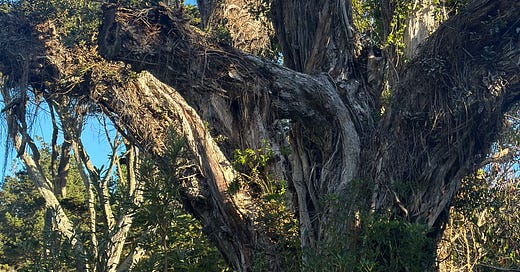Dying trees
With thanks to Jeremy for taking me to see Hilldrop (and for teaching me how to garden tbf)
Dotted through Tresco Abbey Gardens are the mighty, gnarled trunks of Metrosideros excelsa. Upright and beautiful, they are nevertheless dying. Rot has set in on the ends of their trunks.
There are many Metrosideros species growing in the Gardens, but it is excelsa that can reach a height of 18m and, when it is in good health, erupts into a mass of brilliant red flowers that cover the whole tree and make it one of the most wonderfully conspicuous plants in existence. In New Zealand, where it comes from, this spectacle occurs in December so it’s known as the New Zealand Christmas tree.
Though they still tower above us at Tresco, the stumped ends of M. excelsa now have pea climbers and passion flowers threaded up them, where once they continued into branches that blossomed into a shock of red over summer. In a lecture, the curator of the Abbey Gardens Mike Nelhams showed us some pictures of the trees in their former glory.
Since then, the year of 1987 happened, when the garden was hit by five days of snow which wiped out three quarters of its plants. M. excelsa was badly affected as it is a tender tree without much tolerance for hard frost, despite the tolerance of wind and salt spray that ensure it usually does well here. As the trees were so well-established by this time, though, they were gradually able to recover themselves.
It wasn’t till the hard scale set in a few years ago that they suffered irrevocably. This scale was probably brought in by plants from another British or European garden and it has badly affected many of the plants in the Abbey Gardens. Consequentially it has been the topic of countless tea breaks in the shed. No biological control exists within the UK that can be used to manage it so it’s difficult to know how to cope in such a large and open area without cracking out the pesticides.
Now, the Metrosideros offer a spectacle that is still magisterial but in a more muted, senescent way – Sean Connery in The Rock as opposed to Goldfinger. The ageing bark, famed for its hardiness, is a mass of ripples and hollows in a spectrum of brown, silver, mink: the multitude layers and shades divulging the number of years the trees have stood in the garden for. Arguably the most iconic two sit between the lower garden and the middle terrace, next to the old abbey wall. They join together towards the top to form a natural gateway between two areas, letting light in enticingly from the upper side of the garden in the afternoons.
This summer, my former boss Jeremy took the team on a day out to see John Little’s garden, Hilldrop in Essex (the pictures from which I’ve lost too!). It’s an amazing place that also features dead trees but in this case by choice and endeavour rather than natural tragedy followed by imported pest disaster.
John has tried hard to kill off various trees at Hilldrop, including a wild pear tree he took to with a chainsaw and ringbarked several times, and a weeping willow he removed the canopy of. He found that an exhaustive killing was surprisingly difficult to achieve. John wanted to include rotting timber in a garden filled with a vast array of colourful wildflowers that are thriving on ground made of low fertility, recycled materials because incorporating dead alongside living materials encourages much more biodiversity to occur.
Having been inspired by the visit to Hilldrop, I recently interviewed John for The English Garden and he explained of his tree killing habit, “Once a tree is dead, the invertebrates make homes in the peeling bark, meanwhile, insects drive holes into it which bees then take up residence in. Birds then create even bigger holes for shelter. Standing dead trees also offer a different kind of beauty.”
Despite the benefits of dead trees for biodiversity, there’s a huge sadness to losing well-established and well-loved trees. Towards the end of last year, the whole country went into uproar after the Sycamore Gap tree was felled in an inexplicable and enragingly underhand manner overnight. Meanwhile, in another lecture on Italian gardens, Mike showed us photos of a beautiful Kashmir cypress in the Botanic Garden of Isola Madre. It was grown from seed in the nineteenth century and had reached a height of 25m and a whopping diameter of 8m.
Traumatically in 2006, Isola Madre was hit by a whirlwind and the tree toppled over. A miraculous engineering project featuring a helicopter and an elaborate winch system ensued to save the tree. It was resurrected and survives to this day, albeit in a weaker form.
At present, Andrew is grappling over the reality that it might not be safe to allow the trees to stand around the gardens in their current condition, on an island renowned for its loud and destructive winds. It is difficult to find a solution to the problem but it would be a terrible travesty to lose these Metrosideros. So maybe we should just keep them and if someone gets their limbs lopped off by falling timber, then so be it.










